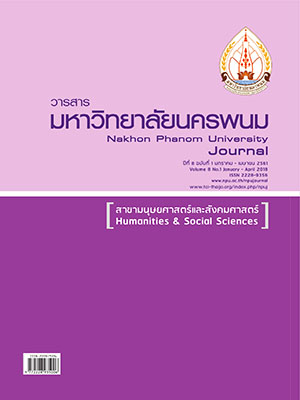ตัวบ่งชี้ผู้บริหารสถานศึกษาที่มีประสิทธิผลสำหรับสถานศึกษาขั้นพื้นฐาน : โมเดลความสัมพันธ์เชิงโครงสร้าง
Main Article Content
Abstract
บทคัดย่อ
การวิจัยนี้มีจุดมุ่งหมายเพื่อพัฒนาโมเดลความสัมพันธ์เชิงโครงสร้างตัวบ่งชี้ผู้บริหารสถานศึกษาที่มีประสิทธิผลสำหรับสถานศึกษาขั้นพื้นฐาน โดยมีวัตถุประสงค์ดังนี้ 1) ศึกษาความเหมาะสมของตัวบ่งชี้เพื่อคัดสรรไว้ในโมเดล 2) ทดสอบความสอดคล้องของโมเดลที่พัฒนาขึ้นจากทฤษฎีและผลงานวิจัยกับข้อมูลเชิงประจักษ์ และ 3) ตรวจสอบค่าน้ำหนักองค์ประกอบขององค์ประกอบหลัก องค์ประกอบย่อย และตัวบ่งชี้ โดยระเบียบวิธีวิจัยเชิงบรรยาย กำหนดขนาดกลุ่มตัวอย่างโดยใช้กฎอัตราส่วนระหว่างหน่วยตัวอย่างต่อจำนวนพารามิเตอร์ 20:1 จากพารามิเตอร์จำนวน 35 พารามิเตอร์ ได้กลุ่มตัวอย่าง 700 คน จากประชากรที่เป็นผู้บริหารสถานศึกษา 30,719 คน เก็บข้อมูลจากกลุ่มตัวอย่างที่ได้มาโดยวิธีการสุ่มแบบหลายขั้นตอน โดยใช้แบบสอบถามเป็นมาตรวัดแบบประเมินค่า 5 ระดับ ที่มีค่าความเชื่อมั่น 0.93 วิเคราะห์ข้อมูลโดยโปรแกรมสำเร็จรูปทางสถิติและโปรแกรมลิสเรล ผลการวิจัยเป็นไปตามสมมุติฐานการวิจัย คือ (1) ตัวบ่งชี้มีความเหมาะสมได้รับการคัดสรรไว้ในโมเดลทุกตัว โดยมีค่าเฉลี่ยเท่ากับหรือสูงกว่า 3.00 และมีค่าสัมประสิทธิ์การกระจายเท่ากับหรือต่ำกว่า 20% (2) โมเดลมีความสอดคล้องกับข้อมูลเชิงประจักษ์ดีมาก พิจารณาจากค่าไค-สแควร์ (c2 ) เท่ากับ 1.48 ค่าองศาอิสระ (df) เท่ากับ 1 ค่านัยสำคัญทางสถิติ (p-value) เท่ากับ 0.22390 ค่าดัชนีวัดระดับความสอดคล้อง (GFI) เท่ากับ 1.00 และค่าดัชนีวัดระดับความสอดคล้องที่ปรับแก้แล้ว (AGFI) เท่ากับ 0.970 และค่าความคลาดเคลื่อนในการประมาณค่าพารามิเตอร์ (RMSEA) เท่ากับ 0.028 และ (3) องค์ประกอบหลักทุกตัวมีค่าน้ำหนักองค์ประกอบสูงกว่าเกณฑ์ 0.70 องค์ประกอบย่อยและตัวบ่งชี้ทุกตัวมีค่าน้ำหนักองค์ประกอบสูงกว่าเกณฑ์ 0.30
Abstract
This research aims to develop a structural relationship model of indicators of effective school principals for basic education schools. The purposes are as follows 1) to study the appropriateness of indicators for selection in the model, 2) to test the congruence of the model developed from theory and research with empirical data, and 3) to investigate the factor loading of major factors, sub-factors, and indicators. Using the descriptive research methodology. The sample size was determined by using the ratio rule between the unit of sample and the amount of parameter 20: 1. From 35 parameters got 700 samples from the 30,719 school principals. Collecting data from the samples selected by Multi-stage Random Sampling by using the 5 level rating scale questionnaire with reliability coefficient 0.93. Data were analyzed by using descriptive statistic, and inferential statistic by statistical program and LISREL Program. Research results were based on the research hypotheses that (1) All indicators were appropriate to be selected in the model, as the mean was equal to or higher than 3.00 and had a distribution coefficient equal to or less than 20%. (2) The model was congruent with the empirical data very well. Considering the Chi-Square Statistics (c2) was 1.48, the degrees of freedom (df) was 1, the statistically significant (p-value) was 0.22390, the Goodness of Fit Index (GFI) was 1.00 and Adjusted Goodness of Fit Index (AGFI) was 0.970 and the Root Mean Square Error of Approximation (RMSEA) was 0.028; and (3) All major factors had a factor loading value higher than 0.70, all sub-factors, and all indicators had a factor loading value higher than 0.30.
Article Details
References
กระทรวงศึกษาธิการ. (2552). สรุปผลการวิเคราะห์คุณภาพแผนพัฒนาจังหวัด/ กลุ่มจังหวัด. เอกสารประกอบการประชุมปฏิบัติการ “เชื่อมั่นประเทศไทยกับการพัฒนาจังหวัดและกลุ่มจังหวัดแบบบูรณาการ”
ไกศิษฏ์ เปลรินทร์. (2552). การพัฒนาตัวบ่งชี้ภาวะผู้นำทางวิชาการสำหรับผู้บริหารสถานศึกษาขั้นพื้นฐาน. วิทยานิพนธ์ปริญญาศึกษาศาสตรดุษฎีบัณฑิต สาขาการบริหารการศึกษา บัณฑิตวิทยาลัย มหาวิทยาลัยขอนแก่น.
เจือจันทร์ จงสถิตอยู่ และแสวง ปิ่นมณี. (2529). ดัชนีทางการศึกษา. พิมพ์ครั้งที่ 2. กรุงเทพฯ: โรงพิมพ์องค์การสงเคราะห์ทหารผ่านศึก.
เชวงศักดิ์ พฤษเทเวศ. (2553). การพัฒนาภาวะผู้นำ
เชิงกลยุทธ์ของผู้บริหารสำนักงานเขตพื้นที่
การศึกษา. วิทยานิพนธ์ปริญญาการศึกษา
ดุษฎีบัณฑิต สาขาวิชาการบริหารการศึกษา
บัณฑิตวิทยาลัย มหาวิทยาลัยขอนแก่น.
นงลักษณ์ วิรัชชัย. (2542). โมเดลริสเรล: สถิติวิเคราะห์สำหรับการวิจัย. พิมพ์ครั้งที่ 3. กรุงเทพมหานคร: โรงพิมพ์จุฬาลงกรณ์มหาวิทยาลัย.
____. (2545). การพัฒนาตัวบ่งชี้สำหรับการประเมินคุณภาพการบริหารและการจัดการเขตพื้นที่การศึกษา. กรุงเทพฯ: ธารอักษร.
____. (2548). แนวโน้มการวิจัยในยุคสังคมความรู้. วารสารบริหารการศึกษา มหาวิทยาลัยขอนแก่น, 1 (2):14-18.
วิโรจน์ สารรัตนะ.(2557). ภาวะผู้นำ: ทฤษฎีและนานาทัศนะร่วมสมัยปัจจุบัน. กรุงเทพฯ: ทิพย์วิสุทธิ์.
___ . (2558). การวิจัยทางการบริหารการศึกษา: แนวคิด แนวปฏิบัติและกรณีศึกษา. พิมพ์ครั้งที่ 4. (E-book) กรุงเทพฯ: ทิพยวิสุทธิ์.
ศูนย์ปฏิบัติการสังกัดสำนักงานคณะกรรมการ
การศึกษาขั้นพื้นฐาน. (2558). ข้อมูลจำนวนครู
สถานศึกษาขั้นพื้นฐาน. ค้นเมื่อ 1 กันยายน
, จาก http://doc.obec.go.th/down load form/insertdata.php.
สำนักงานคณะกรรมการการศึกษาขั้นพื้นฐาน.
(2557). คู่มือการประเมินสมรรถนะ
ผู้บริหารสถานศึกษา (ฉบับปรับปรุง พ.ศ. 2556). ค้นเมื่อ 5 สิงหาคม 2558, จาก
http://www.kroobannok.com/27638
____. (2559). คู่มือการประเมินสัมฤทธิผลการปฏิบัติงานในหน้าที่ ตำแหน่งผู้อำนวยการสถานผู้บริหาร. กรุงเทพฯ: สำนักวิชาการและมาตรฐานการศึกษา.
สำนักงานเลขาธิการสภาการศึกษา. (2559).
ปฏิรูปการศึกษาเพื่ออนาคตประเทศไทย
มั่นคง มั่งคั่ง ยั่งยืน นโยบายด้าน
การศึกษาของนายกรัฐมนตรี. กรุงเทพฯ: 21 เซ็นจูรี่ จำกัด.
American School Counselor Association (ASCA)
and National Association of Secondary
School Principals (NASSP). (2013). A
framework for safe and successful schools.
Retrieved March, 15, 2015, from
http://www.schoolcounselor.org/asca/media /asca/home/frameworkforsafeandsuccessfulschoo lenvironments.pdf
Atlantic International University. (2013). School
management: Characteristics of effective
principal. International Journal of
Advancements in Research & Technology,
volume 2 , issue 10 ,October 2013.
Bagwell, K. (2002). The economics of the world trading system. Brandeis University.
Drucker, P. F. (2009). The effective executive.
New York : . Harper Business; Revised
edition Publisher .
Farrell, A. M., and Rudd, J. M. (2011). Factor analysis and discriminant validity: A brief review of some practical issues. Retrieved January 4, 2011, from http://www.duplica tion.net.au/ANZMAC09/papers/ANZMAC2009-389.pdf
Gold, R.Z. (1980). Introduction to bivariate and multivariable analysis. Illinois: Scott, Forman.
Hoy, W. K. & Miskel, C. G. (2001). Educational administration: Theory, research, and practice. 6th ed. New York: McGraw-Hill.
James, C.R. & Connolly, M. (2000). Collaborative practice: a model of successful working in schools. Retrieved May 10, 2016 From http://dx.doi.org/10 .1108/095782307107
Kerlinger, F.N; & Lee, H.B. (2000). Foundations of behavioral research. 4th edition. Belmont, California: Wadsworth Publishing
McEwan, P. J. (2003). Peer effects on student achievement: Evidence from Chile. Economics of Education Review, 22(2003), 131-141.
Meador, KL. (2013). School of law. Retrieved January 4, 2015, from https://www.law.ua. edu /alumni/alumni-news/november-2013 -meador-lecture/
Nahavandi, A. (2000) The art and science of leadership. U.S.A: Prentice Hall Publisher .
Sheninger, E . (2011). Digital leadership:
Changing paradigms for changing time. A joint publication
Wilson, T. D. (2008). Explaining away a model of affective adaptation. Perspectives on Psychological Science 3(5): 370-386.


